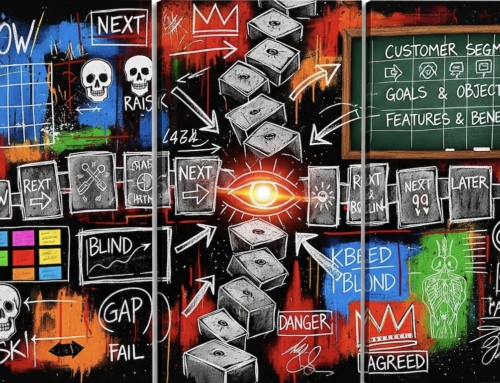
Design Your Sprint Retrospectives and Do Better Scrum
When teaching Certified Scrum Master or Certified Scrum Product Owner courses, I get the sense that many people struggle with Sprint Retrospectives. While people are aware this event is a core part of the framework, I get the impression people are serving up their version of a pastel de nata. Not terrible, but not great…
As a result, many Scrum Teams do not fully embrace their Retrospectives. This is a missed opportunity and why we developed our Retrospective Tune-up, to show Scrum Teams what good looks like. If you’re not ready for a tune-up, this article will offer some helpful ideas on how to improve.
Benefits Provided by a Sprint Retrospective
Retrospectives offer many benefits to Scrum Teams. Here are two benefits that are often overlooked by other writers.
- Slow down for a moment: The Retrospective is an event designed to give the Scrum Team an opportunity to pause. Instead of rushing to complete the next item on the Product Backlog, the Retrospective offers the Scrum Team a chance to stop and reflect. In a world that constantly asks us to hurry up and be busy, taking a moment to stop and think is very powerful.
- Think holistically: In order to deliver their Sprint Goal, the Scrum Team has to zoom in and focus on the details. Being detail oriented is important when the Scrum Team is doing technical work. When the Scrum Team is making choices about how they will build high-quality software that can change over time, this requires a different type of thinking. In times like this, the Scrum Team needs to zoom out and see the big picture.
But to receive any of these benefits, you have to establish a regular cadence of Retrospectives. Unfortunately, many Scrum Teams either give up on the practice or claim “they don’t need Retrospectives.”
Three Reasons Why Many Sprint Retrospectives Fail to Deliver Results
IME, convening an open discussion to “discuss what went well during the Sprint, what problems [the Scrum Team] encountered and how those problems were (or were not) solved” rarely leads to lasting results. Here are my reasons why this occurs.
- Recency bias: An unstructured open discussion often focuses on impediments that have occurred in the recent past (aka recency bias). As a result, the Scrum Team’s discussion will drift towards how they plan to alleviate the impediment’s symptoms rather than explore the factors which contributed to the impediment’s root cause(s).
- Lack of design: When the Scrum Team needs to address a new and unusual impediment, they will have more success to eliminate that impediment when the Retrospective experience is designed. Someone must take ownership to design the experience or the group’s return-on-time- invested will be low.
- Ignore brain science: The human brain craves newness, variety and likes to solve puzzles. However, the brain is easily distracted once it is bored. A stale and monotonous Retrospective format is why many Scrum Team (brains) lose interest in Retrospectives.
Five Steps to an Effective Sprint Retrospective
We all know that Retrospectives are collaborative, problem-solving sessions, but did you know that the best Retrospectives follow a five-step process? In an earlier article, I reviewed the classic book, Agile Retrospectives: Making Good Teams Great, that first introduced this design in 2006. Today, we have a second edition of this book, which should be required reading for ALL ScrumMasters. For those who are unfamiliar with this framework, here are the five steps
- Set the stage
- Gather data
- Generate insights
- Decide what to do
- Close
The five-step Retrospective format offers an additional benefit, it helps keep the brain engaged. During an open discussion, ideas are flying around and the brain can become distracted. A five-step Retrospective allows the brain to focus its attention on completing the task of each stage before moving to the next topic, increasing the likelihood that impediment becomes resolved.
Introducing Retromat
Another way to capture the brain’s attention is to vary the activities in each Retrospective. Because each Retrospective experience is new, the brain has to pay attention. When I was doing ScrumMaster work, the Agile Retrospectives book was my main resource for selecting Retrospective activities. Today, I use Retromat.
Retromat is a free, online tool created by Corinna Baldauf. In 2012, Corinna wanted to create and design interesting Retrospectives for her Scrum Team. Apart from the Agile Retrospectives book and a few other websites, there was not much out there and this frustrated her. To fix this gap in the market, she published the Retromat book.
Today, the online version of Retromat offers lightweight instructions on how to facilitate over 140 Retrospective activities. Each activity is assigned to one of the five Retrospective steps and many activities have pictures that help with facilitating the activity. In addition, the site has been translated into nine languages. The best ScrumMasters use Retromat.
Introducing a Sprint Retrospective Theme
A Sprint Retrospective theme is a unifying topic, or collective problem, the group wants to resolve by conducting a Retrospective. When the Scrum Guide recommends a discussion about “what went well during the Sprint, what problems [the Scrum Team] encountered and how those problems were (or were not) solved,” it suggests the default Sprint Retrospective theme is improving team performance.
But as I noted earlier, the brain wants newness and variety. Constantly returning to the same theme of improving team performance drives the brain to boredom. In scenarios where the theme is repetitive, the brain anticipates what is expected of it and goes on autopilot. And because it’s a brain, it thinks about something more interesting as the group recites the same blah blah blah about “what went well, what didn’t go well…” every Sprint.
To sustain the brain’s interest, the Retrospective theme also has to change. There are many, many themes to choose from and the Scrum Guide suggests a few: “individuals, interactions, processes, tools and… Definition of Done”. If you cannot think of a theme, I recommend that you ask your Scrum Team. They will have plenty of ideas.
Putting it All Together with Retromat
For example, many Scrum Teams complain about their user stories1. If I were asked to design a five-step Retrospective to improve a Scrum Team’s user stories, here are the activities I would select from Retromat.
- Set the stage: Three words (#82)
- Gather data: Analyze stories (#5)
- Generate insights: Perfection game (#20)
- Decide what to do: Three by three (#125)
- Close: Pleased & surprised (#45)
When reviewing this design please keep in mind two ideas. One, when the instructions refer to iterations (or Sprints), we would talk about the team’s user stories. Two, these are not the only activities we could use for this Retrospective. For instance, in step #2 (generate data), I could have easily selected Story Oscars (#45).
Taking time to improve your Sprint Retrospectives can enhance your Scrum Team’s effectiveness. Small changes, like incorporating a five-step Retrospective and tools like Retromat into your design, will help keep the Scrum Team engaged. Remember, the goal of Retrospective is to create a habit of continuous improvement through the process of inspect-and-adapt. Good luck!
1 – This is such a recurring problem, that The Scrum Academy has designed a User Story Team Tune-up to help improve the use of user stories. If this is a problem your team has, we are here to lend a hand.





